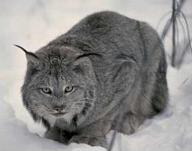

Genus: Lynx
Species: canadensis

A not so common animal is the Canadian lynx. The lynx is almost identical to a regular house cat, but larger. It has a powerful body on short, furry legs attached to hefty feet, and a bobbed, black-tipped tail. Its fur is spotted and yellowish-brown to grey. It has a collar of fur around its face, giving a triangular shape. It also has long black ear tufts.
It is quick and sly, and can strike an animal at any moment. The lynx mainly hunts snowshoe hares, but also eats meadow voles, small deer, caribou and sheep.
It has eyes that provide excellent vision for the night, and it's feet have fur covered pads and are silent in the snow so it can sneak up on small prey. It isn't very fast so it has to ambush an animal instead of chasing it down.
The lynx can grow up to 2 -4 feet as an adult, and is about 2 feet high in the shoulders. It weighs about 11 - 45 pounds.
The male has a hunting range of about 20 square miles and females have about half that size. It likes to travel alone, and searches up to twelve miles during the night in search of food. In the spring the female will have a litter of four kittens under a log or bush. The kittens are born blind and helpless, and grow slowly. They are weaned at two months but stay with their mother for about a year.
The lynx lives deep in the coniferous forest and mountains of Canada and the northern United States. It can be found scattered through Europe, across northern Asia and Siberia.
There aren't as many lynxes because their habitats are being destroyed. They are also hunted for their fur and meat. In Europe the lynx has almost been wiped out because farmers think it is a pest and that it kills sheep, goats and other livestock. It is waiting to be put on the endangered list in the United States. With strong laws to protect it the lynx is making a slow comeback.
by Dillon B. 200o.
Bibliography:
"Northern Lynx", http://www.lam.mus.ca.us/~pcannon/cats/northern.html, (June 2000).
"Taiga Animals", http://mbgnet.mobot.org/sets/Taiga/animals/index.htm, (June 2000).